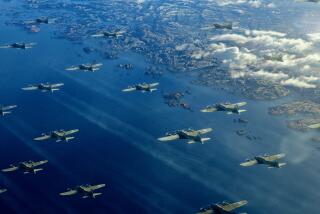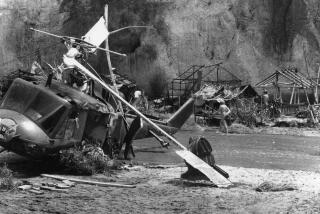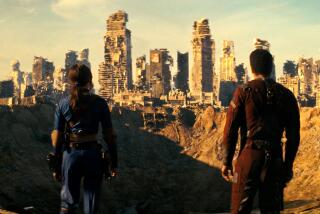The ‘Mission: Impossible — Fallout’ team reveals the secrets of pulling off that climactic helicopter chase
Warning: This story contains plot spoilers about “Mission: Impossible — Fallout.”
Christopher McQuarrie wasn’t getting much sleep. Every night, like clockwork, the “Mission: Impossible — Fallout” director would wake up in the middle of the night, his mind racing with worries about the film’s climactic helicopter chase.
“You’re stuck in a loop where your mind is constantly thinking about all the things that could go wrong,” McQuarrie says. “That keeps you up until around 6 in the morning.”
Shot over six weeks over mountainous terrain on the South Island of New Zealand, the high-speed aerial chase – with Tom Cruise, as superspy Ethan Hunt, in pursuit of Henry Cavill’s villainous August Walker – was perhaps the most ambitious and dangerous action sequence ever attempted in a “Mission” film. And given the number of death-defying stunts that Cruise had personally performed over the course of the franchise’s history – including scaling the world’s tallest building and clinging to the side of a plane during takeoff – that’s saying something.
“It was so big and so overwhelming,” says McQuarrie, who also scripted the sixth installment in the action franchise, which opened this weekend. “We didn’t know how big a bite we were biting off before we did it. It’s a very scary way to make a film. It’s also intensely invigorating.”
Though it’s all seamless on screen, that chase and the film’s final cliff-side slugfest were shot in three separate countries under extreme conditions including subfreezing temperatures and an injured leading man. Here, McQuarrie, stunt coordinator Wade Eastwood and Cavill break down what went into the grand climax.
1. The long line stunt
The sequence begins with Cruise’s Hunt attempting to get onto a helicopter as it’s taking off by grabbing onto the long line that carries its payload. As the helicopter soars into the air, Hunt climbs up the rope, only to slip and fall backward 40 feet and slam into the cargo.
While it would have been easy enough (and needless to say, far safer) to shoot the stunt on a studio backlot against a green screen, that’s not how Cruise rolls. True to form, the 56-year-old actor wanted to do it for real.
Eastwood and his team rigged up a complicated pulley system and safety line so that Cruise could perform the stunt with some degree of control. But given the speed at which he needed to plummet – and the fact that he was doing it backward – there were still tremendous risks.
“The only thing the safety line was ensuring was that if Tom was killed during the stunt, we wouldn’t be looking for his body in the bushes,” McQuarrie says dryly. “Because if he made the fall at the wrong angle, it’s picture wrap on Mr. Cruise. If he hits the payload headfirst as opposed to back first or legs first, he’ll break his neck and just be a rag doll.”
Watching from the ground, Cruise’s costars didn’t realize at first that the fall was intentional and feared that the actor – who had already broken his ankle jumping from one building to another in an earlier stunt, forcing the production to shut down – may have hurt himself again.
“When he first dropped, they all screamed because they thought he’d actually fallen off the helicopter,” Eastwood says, laughing. “They were almost booking holidays and packing up their bags.
“Everyone always asks me if this is Tom Cruise just going mad and wanting to do all this stuff, but it’s really not that,” he continues. “He approaches everything in a calculating fashion. He would have been a great stunt man if he wasn’t a great actor.”
2. The chase
Cruise has been a licensed pilot for many years and flown helicopters before, but in order to be able to pull off the difficult maneuvers involved in the chase on his own – including a perilous downward spiral – he underwent intensive training, spending 16 hours a day for more than a month honing his skills.
Having Cruise fly the helicopter himself wasn’t just a way for the actor to get his thrill-seeking kicks. The aim was to create the most immersive white-knuckle experience possible for the audience. To that end, special camera mounts were fixed to Cruise’s helicopter so the audience could see that he was flying solo.
“It’s hard to do a helicopter sequence that’s interesting,” Eastwood says. “We thought, how do we stay with the characters so it’s not just two helicopters in this massive canyon and it’s boring? It’s all Tom flying, 100% of it. There’s a lot of jeopardy – we’re flying in close proximity to other helicopters, in close proximity to the sides of the mountain – but the way we shot it, we keep it with Tom and keep it subjective.”
Though his own helicopter was being flown by a professional pilot, Cavill still keenly felt the dangers (not to mention the bone-chilling, minus-22-degrees cold).
“All it takes is one person to make a mistake for everyone to go down,” Cavill says. “Even if Tom is flying perfectly, if my pilot has one little error in judgment trying to anticipate a gust or something, we all turn into a giant fiery ball of fun. That’s what made it so spectacular. It kind of stops being a stunt and becomes something else entirely.”
3. The crash
McQuarrie knew he needed to eventually get the characters onto the ground for their final mano-a-mano fight and decided to do it in the most violent way possible, with their choppers crashing down after a mid-air collision.
The crew staged the crash on a backlot of Leavesden Studios in England, putting Cruise’s helicopter on winches and slamming it onto a snow-covered slope at high speed. Special rigs were then constructed so that both helicopters could slide and roll down the slope with the actors bouncing around inside.
“It’s kind of like being in a theme park ride but really dangerous because your limbs are flying everywhere and all you need to do is catch your wrist in the wrong place and that’s a permanent injury,” Cavill says. “We got away with it, fortunately.”
Eventually the two downed helicopters fall into a crevasse (also constructed at Leavesden), where – in a moment of absurdist near-slapstick – they hang inverted and crash into each other.
“When Tom and I talk about a ‘Mission: Impossible’ movie, the first conversation we have is about Buster Keaton and Harold Lloyd and Charlie Chaplin,” explains McQuarrie. “What’s great about these characters is they do not want to be in this situation that they’re in. They’re not heroes. They are victims of a set of horrible, horrible circumstances.”
4. The fight
The sequence climaxes with Hunt and Walker, each seriously injured from the crash (and Cruise in reality still recovering from his shattered ankle), fighting on the side of a steep cliff.
Looking for a suitably forbidding-looking location, McQuarrie settled on Norway’s Preikestolen, or Pulpit Rock, a cliff with a flat top that rises 2000 feet above a fjord. With the exception of a few moments of Hunt and Walker hanging from the side of the cliff that were filmed on a 70-foot-high set at Leavesden, the entire fight was shot over three days on location.
“The texture of everything, the depth of that fjord – you could never replicate that on a stage,” Eastwood says. “It was such a threatening location that it brought out a certain difference to the fight.”
“You’re standing on the edge and looking down and thinking, ‘What would it feel like if I fell?’ ” Cavill says. “You imagine the rig failing and plummeting to your death. But at the same time, it was absolutely stunning.”
Having pulled off this intensely complicated and dangerous sequence – which, in its entirety, took as long to shoot as many feature films – McQuarrie and Cruise have already started kicking around ideas for how they could possibly top it next time.
“Tom and I saw the movie together the first time at the premiere in Paris,” McQuarrie says. “At the end of the movie, it cuts to the title right before the credits and the final note had not finished ringing out before Tom turned to me, nudged me with his elbow and said, ‘Yeah, we can do better.’ ”
Twitter: @joshrottenberg
More to Read
Only good movies
Get the Indie Focus newsletter, Mark Olsen's weekly guide to the world of cinema.
You may occasionally receive promotional content from the Los Angeles Times.











